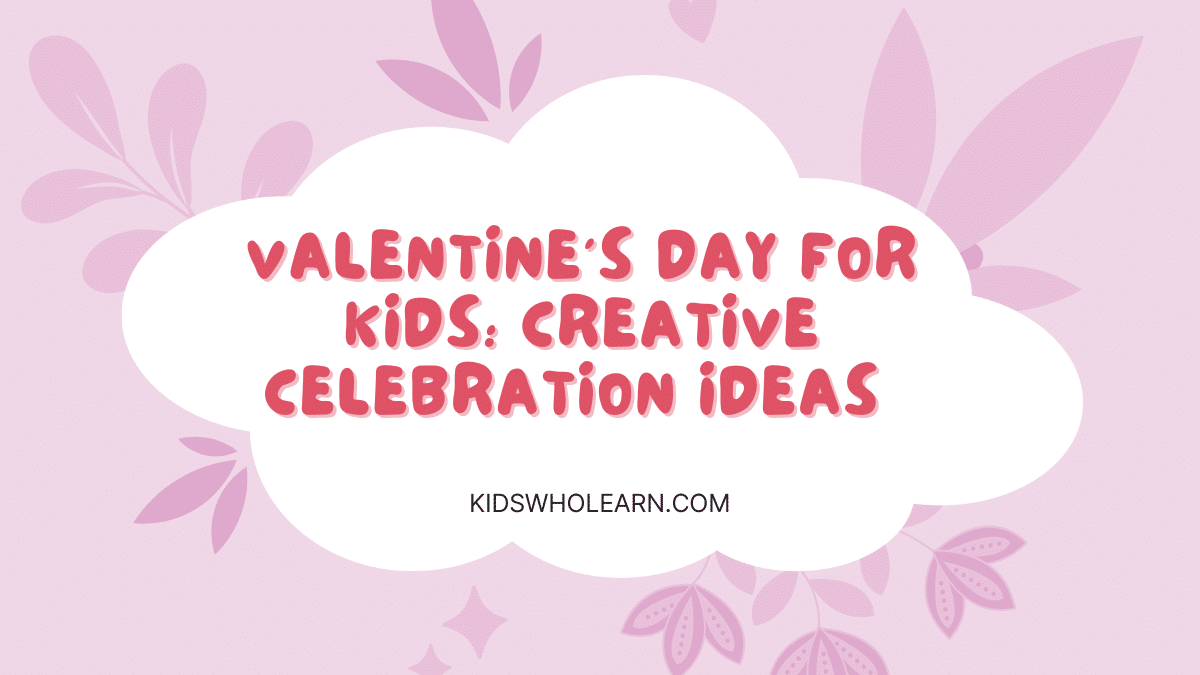Valentine’s Day is a special occasion that isn’t just for adults—it offers a unique opportunity for kids to express kindness and appreciation for their friends, teachers, and family members. Alongside the tradition of exchanging cards, children can engage in various activities that promote creativity, caring, and fun. Crafting personalized Valentine’s cards, for instance, allows kids to explore their artistic side, while learning the value of putting effort into handmade tokens of friendship.
In the classroom and at home, Valentine’s Day can be transformed into an educational experience with themed activities that make learning interactive. Stories and books themed around love and friendship can be powerful tools for children to understand emotions and relationships. Moreover, incorporating this theme into math or language arts lessons can add a festive twist to standard curricula. On top of that, Valentine’s Day provides an excellent chance to discuss healthy treat options, the joy of giving and receiving, and to answer common questions kids might have about the day.
Key Takeaways
- Valentine’s Day activities for kids foster creativity and emotional intelligence.
- Themed educational activities can make learning enjoyable and relevant.
- Incorporating traditions like card giving into the day teaches valuable social skills.
Significance of Valentine’s Day for Kids
Valentine’s Day is a time when we often think about expressing love and appreciation toward others. For kids, this holiday can play a special part in teaching them about the importance of showing kindness and consideration.
Expressions of Affection:
Valentine’s Day gives us an opportunity to assist children in understanding the value of expressing affection to friends and family members. Crafting valentines, small gifts, or notes can be a practical way for kids to communicate their feelings.
Friendship and Social Skills:
Children can use Valentine’s Day to strengthen friendships by exchanging valentines at school. This exchange helps develop social skills and the ability to navigate relationships.
Lessons in Generosity:
We can encourage children to explore the joy of giving without expectation of something in return. It’s a perfect time for them to learn about the satisfaction that comes from making someone else smile.
Cultural Understanding:
Introducing them to how Valentine’s Day is celebrated around the world can broaden their horizons. It’s an educational moment to discuss similarities and differences in traditions.
Inclusive Celebrations:
We ensure that everyone feels included. Valentine’s Day can teach children to extend their kindness to all of their peers, fostering an environment of inclusivity.
By approaching Valentine’s Day with these focuses, we help children experience the holiday as more than just a day for candy and cards, but as an occasion for personal growth and learning about the many forms love can take.
Crafting Valentine’s Day Cards
Making Valentine’s Day cards is a fun and creative way for us to express our feelings. We can make unique and personal cards with just a few materials and some simple ideas.
Choosing Materials
When we start our card-making project, it’s important to select the right materials. Here’s what we’ll need:
- Paper: Construction paper, cardstock, or even colored printer paper.
- Decorations: Stickers, glitter, ribbons, and felt shapes add character to our cards.
- Writing utensils: Markers, pens, and colored pencils for adding messages.
- Glue: Stick glue is less messy, but liquid glue can be useful for heavier decorations.
- Scissors: Child-safe scissors are crucial for cutting paper and decorations.
Simple DIY Card Ideas
We can create beautiful cards with these easy designs:
- Heart Pop-Up Card:
- Cut a heart shape from a piece of colored paper.
- Make two cuts in the heart’s fold, creating a tab that we can fold back to create a pop-up effect when the card is opened.
- Collage Card:
- Cut out images and motifs from old magazines or wrapping paper.
- Arrange and glue them onto the front of our card to create a thematic collage.
- Stencil Art Card:
- Use stencils to trace shapes like hearts or Cupid onto the front of our card.
- Color them in or decorate them with glitter for a special touch.
- Fingerprint Art Card:
- Dip thumb or fingertip in ink or paint to make fingerprint hearts or animal shapes.
- Add details with a marker to finish off the design.
Safety Tips for Crafting
Safety is paramount when we craft. Here are some safety tips to keep in mind:
- Always use child-safe scissors to prevent cuts and accidents.
- Use glue and other craft supplies in a well-ventilated area to avoid inhaling fumes.
- Supervise the use of decorative items like beads or buttons that could be choking hazards.
- Keep a clean workspace to prevent spills and mishaps with scissors or glue.
Valentine’s Day Classroom Activities
We focus on inclusive and fun activities that allow children to celebrate Valentine’s Day in the classroom, fostering a sense of community and creativity.
Exchange of Valentines
Each student is encouraged to prepare a Valentine card or small token to exchange with their classmates. It’s important to ensure everyone receives something to feel included. Here is a simple method we can use:
- Create Valentines: We provide materials like colored paper, stickers, and markers for students to create their own Valentine cards.
- Decorate Mailboxes: Shoeboxes or paper bags can be decorated and named for each student to serve as personal “mailboxes.”
- Distribute Valentines: On Valentine’s Day, we allow time for students to place their Valentines in each other’s mailboxes.
Themed Educational Games
Integrating the Valentine’s Day theme into our learning can be both engaging and educational. A few themed games we can introduce are:
- Word Finds: Word searches with Valentine’s vocabulary to build language skills.
- Math Match: Heart-shaped cards with math problems on one side and answers on the other for matching.
Creative Art Projects
Artistic expression is a wonderful way for children to celebrate Valentine’s Day. Some art projects we can organize include:
- Crafting Love Bugs: Using pom-poms, googly eyes, and pipe cleaners, students can create Valentine “love bugs.”
- Heart Collage: Collecting various materials, students make heart-shaped collages reflecting what they love or enjoy.
Healthy Valentine’s Day Treats
Valentine’s Day is the perfect occasion to show love and care through nutritious and delightful snacks. We can create tasty treats that are both heartfelt and health-conscious.
Fruit-Based Snacks
Fruit is a naturally sweet choice for Valentine’s Day treats. Try these:
- Fruit Kabobs: Skewer a mix of strawberries, grapes, and melon balls.
- Berry Mix: Fill small cups with raspberries, blueberries, and sliced strawberries.
Heart-Shaped Delights
Shaping food into hearts makes healthy eating fun:
- Heart-Shaped Sandwiches: Use a cookie cutter on whole-grain bread and fill with tuna or chicken salad.
- Vegetable Hearts: Slice carrots and cucumbers with heart cutters for a nutritious snack.
Allergy-Friendly Options
We ensure everyone can enjoy Valentine’s treats without worry:
- Gluten-Free Heart Cookies: Make them with gluten-free flour and a touch of honey.
- Dairy-Free Chocolate Dip: Blend cocoa powder with avocado for a creamy dip; serve with apple slices.
Valentine’s Day Stories and Books
We’ve curated a cherished collection of tales centered on love and friendship, perfect for young readers on Valentine’s Day. These stories range from classics that have stood the test of time to interactive books that engage children’s imaginations.
Classic Love Tales for Children
- Beauty and the Beast: A timeless story that emphasizes the beauty within.
- Cinderella: An enchanting tale of kindness, love, and magical transformation.
Inspirational Stories on Friendship
- Winnie the Pooh by A. A. Milne: Showcases the power of friendship through Pooh and his friends.
- Charlotte’s Web by E.B. White: Details the compassionate bond between Charlotte and Wilbur.
Interactive Valentine’s Day Reading
- The I LOVE YOU Book by Todd Parr: Features bold illustrations and simple affirmations of love.
- My Fuzzy Valentine by Naomi Kleinberg: An engaging touch-and-feel book.
Outdoor Valentine’s Day Fun
Valentine’s Day isn’t just for indoor activities; it’s a perfect opportunity for us to step outside and enjoy some heart-themed fun.
Themed Scavenger Hunts
We can organize a scavenger hunt where kids search for Valentine’s Day related items. Prepare a list of valentine-themed objects like heart-shaped stones, red objects, and love-themed notes that we hide around the yard. We use a checklist to make it engaging:
- Red ribbon
- Heart-shaped leaf
- Love note in a bottle
- Rose petal
Valentine’s Day Races
Valentine’s Day can be active with races designed around the theme. For example, we could have a “Cupid’s Arrow Dash” where participants run with a ‘quiver’ of arrows to deliver messages to different ‘hearts’ stationed across a course.
- Cupid’s Arrow Dash: Race to deliver ‘arrows’ with attached messages.
- Hopping Hearts: A sack race where each sack is decorated with hearts.
- Love Relay: Passing a heart-shaped baton among team members.
Family Picnic Ideas
We organize a Valentine’s Day picnic with heart-shaped sandwiches and pink lemonade. Here’s a simple menu we could use:
| Item | Description |
|---|---|
| Heart Sandwiches | Use a cookie cutter for heart shapes. |
| Berry Salad | Mix strawberries and raspberries. |
| Pink Lemonade | Add a drop of red food coloring. |
| Chocolate Strawberries | Dip strawberries in melted chocolate. |
By focusing on these outdoor activities, we provide a memorable and active way to celebrate Valentine’s Day with children.
Valentine’s Day Themed Learning
Valentine’s Day provides a unique opportunity to explore different subjects through the lens of love and affection shared across the globe. In this section, we take a closer look at the historical roots of Valentine’s Day, examine how love is expressed differently across cultures, and discover how various countries celebrate this special day.
History of Valentine’s Day
Valentine’s Day originated as a Western Christian feast day honoring an early saint named Valentinus. Over the years, it has evolved into a significant cultural and commercial celebration of romance and love in many regions of the world. One popular Valentine’s Day story suggests that Saint Valentine of Rome was imprisoned for performing weddings for soldiers who were forbidden to marry. According to legend, he healed the daughter of his jailer, and before his execution, he wrote her a letter signed “Your Valentine” as a farewell.
Expressions of Love in Different Cultures
Different cultures have unique ways to express love, especially during Valentine’s Day. For example:
- Japan: Women often give men chocolates, with different types signifying the nature of the relationship. Giri-choco (obligation chocolate) is given to friends, colleagues, bosses, and close male friends. Honmei-choco (true feeling chocolate) is reserved for a boyfriend, lover, or husband.
- Wales: The Welsh celebrate love on St. Dwynwen’s Day (January 25th). A traditional gift is a hand-carved wooden spoon, known as a “lovespoon,” which symbolizes one’s affection.
Valentine’s Day Around the World
Valentine’s Day is observed differently across the globe, each with distinct traditions:
- United States: It’s common to exchange cards, flowers, and chocolates. Schools often have Valentine’s Day activities where students exchange valentines.
| Country | Custom |
|---|---|
| Brazil | “Dia dos Namorados” is celebrated on June 12, with music festivals and performances. |
| Italy | Couples enjoy romantic dinners; in some parts, “baci” or kisses are exchanged. |
| South Korea | Celebrations continue on the 14th of each month, with special themes like “Kiss Day,” “Hug Day,” and “Music Day.” |
Gift Giving and Receiving
In Valentine’s Day celebrations, we often express our feelings through the exchange of gifts. It’s a time where creativity and thanks go a long way.
Homemade Gift Ideas
We can use simple materials to craft thoughtful presents. Consider these ideas:
- Cards: Use construction paper, stickers, and markers to make unique cards.
- Photo Frames: Decorate wooden or cardboard frames with paint, glitter, and beads.
- Baked Goods: Cookies and cupcakes decorated with hearts show creativity and care.
The Joy of Sharing
Sharing is a heartfelt part of Valentine’s Day. Even simple gestures make a difference:
- Giving flowers or cards to friends and family.
- Sharing a favorite book or toy with a classmate.
- Bringing homemade treats to share with classmates.
Gratitude and Appreciation
After receiving gifts, we show appreciation. Here’s how:
- Saying “Thank you” to each person who gives you a gift.
- Writing thank you notes for more personal acknowledgment.
- Expressing joy with a smile, showing that their gift means a lot to you.
Printable Valentine’s Day Activities
We’ve gathered a selection of fun and engaging printable activities that kids can enjoy this Valentine’s Day.
Coloring Pages
- Hearts Galore: Find coloring sheets featuring various heart designs.
- Valentine’s Characters: Color Cupid, love birds, and friendly monsters with hearts.
Puzzles and Word Games
- Word Search: Search for Valentine’s-themed words in a letter grid.
- Mazes: Help Cupid find his way to the heart in the center of the maze.
- Crosswords: Use Valentine’s Day clues to fill in the crossword puzzles.
Cut-out Decorations
- Heart Chains: Print, color, and cut out heart-shaped links to create decorative chains.
- Door Hangers: Personalize and cut out themed door hangers with Valentine’s messages.
Frequently Asked Questions
In this section, we’ll cover the most commonly asked questions about enjoying Valentine’s Day with kids. We aim to provide practical ideas and share some historical insights suitable for young minds.
What are some age-appropriate ways to celebrate Valentine’s Day with children?
We can celebrate Valentine’s Day with children by encouraging them to make handmade cards or bake heart-shaped cookies together. Organizing a small Valentine’s party with games and themed snacks can also be delightful.
Can you suggest some kid-friendly Valentine’s Day crafts or activities?
Certainly. We can help kids create paper heart chains, design custom valentines, or have fun with a Valentine’s Day-themed scavenger hunt. Crafting friendship bracelets or painting rocks to hide in the community can also be a hit.
What is the historical significance behind Valentine’s Day that can be shared with kids?
We can share with kids that Valentine’s Day dates back to ancient Rome and is thought to celebrate love and kindness. It’s associated with Saint Valentine, who was known for sending the first ‘valentine’ greeting.
How can schools or youth groups incorporate Valentine’s Day into educational activities?
Schools or youth groups can include Valentine’s Day in their activities by having children write poems about friendship, learn about the heart as a symbol, or discuss the importance of showing appreciation to others.
What are some simple and meaningful Valentine’s gestures for children to participate in?
We can guide children to perform simple gestures like sharing compliments, writing thank-you notes to family members, or helping to prepare a meal as ways to express love and care on Valentine’s Day.
How do different cultures celebrate Valentine’s Day, and what lessons can kids learn from them?
We can teach children that Valentine’s Day is celebrated differently around the world, with some countries putting a focus on friendship rather than romantic love. From this, kids can learn about cultural diversity and the universality of love.










